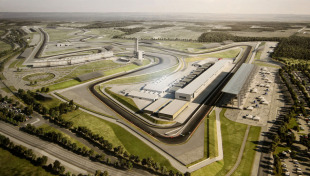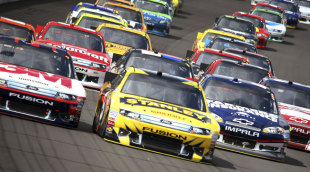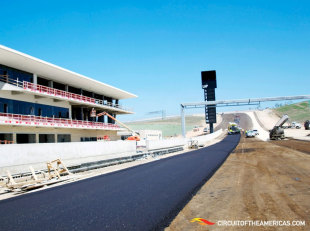
Austin, Texas, doesn't seem the most likely place for a grand prix. The American city is renowned for its barbecues, its emerging importance as a technology centre, and for the legendary South By Southwest festival (SXSW), an annual gathering of film buffs, musos, and technology geeks.
Eyebrows were raised back in May 2010, when Bernie Ecclestone and Tavo Hellmund announced that Formula One would be returning to the United States of America, and that the sport's new home would be a purpose-built race track in the heart of the Lone Star State.
The flyover states are generally seen by Europeans - of which there are many in Formula One - as the NASCAR heartlands, with F1's limited American fanbase residing primarily on the two coasts. Indianapolis was one thing, as the Brickyard is heaving with motorsport history, but a trip to Texas first looked like it would be yet another own goal on F1's list of repeated attempts to break America.
And it could still turn out that way - the first American F1 race in five years has been scheduled to take place on the same date as the NASCAR Sprint Cup season finale. Many existing U.S. motorsport fans are expected to prioritise the NASCAR race, both as ticket-holding attendees and as eyeballs on TV screens.
Which isn't to say ticket sales aren't strong in Austin. In June the Texas race organisers added two new grandstands at Turns 9 and 11 to cope with unexpected levels of demand, and advance sales have continued to be strong. Fans are expected to travel from Central and South America in droves, with Mexican fans able to visit the race by car.
Locally, the grand prix has been divisive. The construction work has created jobs in the area, while a planned educational tie-in with local universities has garnered good PR. The inclusion of an amphitheatre for year-round concerts has proved popular, but the majority of column inches in the local press have concentrated on the numerous lawsuits and battles that have plagued - but not derailed - the project.
From a high-profile split between original promoter Hellmund and his partners in the project, which led to a lawsuit, to vocal opposition to plans to use the state's Major Events Trust Fund to pay the race-hosting fee, the Austin race has seen a lot of negative publicity.
But while much has been made in the media of local opposition to the race, which a number of Austinites view as an unnecessary expense in an era of budget cuts amid a global economic downturn, little has been made of the other local reaction: a complete lack of awareness that Formula One will be coming to town.

One seminar at this year's SXSW, Formula 1: Driving Global Technology & Innovation, looked at the logistics of hosting a grand prix. And in the post-seminar discussions, it emerged that a sizeable number of Austin natives who had attended the talk were not aware of the fact that the grand prix had been confirmed, let alone that construction had been underway for over a year and the race was due to take place in eight months' time.
Despite the occasional teething problem, the Circuit of the Americas is on track to host its maiden grand prix in a little under three months' time. The track itself has been designed as something of a love letter to F1's classic corners, both those long gone and those still in use, and as a result promises good racing.
Turns 3 to 6 echo Silverstone's Maggots-Becketts complex. Turns 12 to 15 have something of the Hockenheimring's Arena about them, while Turns 16 to 18 are an homage to Istanbul's Turn 8, Hermann Tilke's most popular corner. Elsewhere, COTA has gone for the evocation, rather than the replica. Corners at the Texan track have been inspired by Interlagos and the Osterreichring.
Despite the promise of an exciting debut, there are still some obstacles yet to overcome in Austin. On August 10, workers began the two-month process of preparing the track surface for November's race. Using a technique known as echelon paving, multiple paving machines will move as one along the length of the track, leaving in their wake a highly specialised surface that is both smooth enough and safe enough for grand prix racing.
Until that job is complete, FIA race director Charlie Whiting will not be able to give the Circuit of the Americas the official seal of approval. Final homologation is scheduled to take place on 25 September, the FIA-mandated minimum of sixty days before the race, but the track is expected to pass muster.
Whiting has been a semi-regular visitor to the Austin construction site since development work began in January 2011, and will next inspect the track at the end of this month. During his last inspection, which took place in June, the FIA race director was fulsome in his praise of the work in progress.
"It is clear that the significant resources Circuit of the Americas has committed to completing this facility on time and to FIA specifications is making a difference," Whiting was quoted as saying by a COTA statement released at the time. "The more than 500 construction workers on site daily are making great progress, and I plan to return to Austin at the end of August for an update.
"From the world-class motorsports facilities and fan areas to the racecourse itself, which promises to be one of the most challenging new additions to our season, I believe Circuit of The Americas has the ability to put on a great show and spectacular Grand Prix in its inaugural year. I look forward to my next visit in August."
While passing FIA inspection is vital to the race's success, there remain obstacles that the Austin race organisers have yet to face. One of the main concerns raised by both locals and members of the F1 circus is access to the circuit. The Travis County race track is currently accessible by only two major roads, and traffic management is going to play a vital role in the public's response to the race.

A worst-case scenario would see a repeat of the inaugural Korean Grand Prix, which took place in 2010. With only one road serving the Yeongam International Circuit, race day saw thousands of ticket-holders miss the start of the grand prix, as cars were caught in long tailbacks. The traffic only worsened as fans abandoned their cars where they lay and walked the rest of the way to the track.
But provisions are being made in Austin to lessen the vehicular impact. Representatives from COTA were at this year's British Grand Prix on a reconnaissance mission, and so were able to observe first-hand as Silverstone officials did their best to rectify the traffic chaos that cast a shadow over the weekend's racing.
Rather than close the stable door after the horse has bolted, COTA are attempting to nip potential traffic jams in the bud by encouraging fans to park in designated parking lots in and around Austin, travelling to and from the track via a free shuttle service.
But there is a spanner in the works where access is concerned. One of the two major roads into the circuit has long been scheduled for redevelopment, in part because it needs to be widened and in part because the unstable earth on which the road was built means a mile-long stretch has what locals describe as a "rippled" surface. While the county have plans to repair the affected roadway, it will not be done before the lights go out in November.
"I don't think it's possible for them and us to get everything worked out and get the [road improvements] designed, permitted and built by the time they have their first race," Steve Manilla, Travis County's transportation and natural resources director, told local paper the American Statesman in January.
In less than three months' time, the maiden Austin race will already be a thing of the past. The F1 circus will have moved on to Interlagos, leaving in their wake a trail of champagne corks and melted rubber. For those involved in the effort of bringing Formula One to Texas, it will be an opportunity to sit back, reflect on their successes and failures, and begin preparations for their sophomore year.
Until then? There's still a lot of rippled road for the race organisers to travel.

